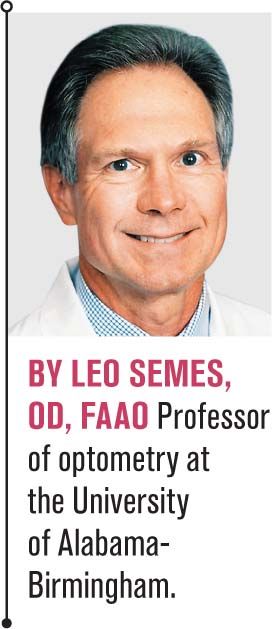Evaluating myopic maculopathy
A 12-year-old Hispanic male was evaluated for fundus appearance at the ocular disease service at University of Alabama at Birmingham (UAB) Eye Care.

A 12-year-old Hispanic male was evaluated for fundus appearance at the ocular disease service at University of Alabama at Birmingham (UAB) Eye Care. Medical and personal histories were paltry but included developmental delays and poor vision with horizontal nystagmus. No medications were reported.
The patient was able to fix and follow a light stimulus, but visual acuity beyond that was unobtainable. Pupils were reactive and equal. Dilation was attained using 1% tropicamide alone, which was difficult to instill.
Figure 1 shows the fundus appearance of each eye on March 17, 2015. Noteworthy is that objective refraction was -9.50-2.00 X 180 OD and -9.25 – 2.25 X 010 OS, which did not improve visual acuity to a measurable level.
The patient’s initial encounter at UAB Eye Care was in June 2012. Figure 2 shows the fundus appearance of each eye from that visit. Note the remarkable similarity over the course of two and a half years.


Myopica maculopathy
Myopic maculopathy has been characterized recently as an outcome of international consensus and will likely become a landmark.1 The five-step hierarchy is shown in Table 1.1 The authors also append several observations to better define the clinical appearances encountered.
Since the classification of myopic maculopathy has remained unchanged for nearly 45 years,2 this is a refreshing categorization for clinical consistency. While some geographic disagreement exists over the level of myopia to qualify as high for classification purposes, the threshold hovers between -5.00 D and -6.00 D. Histological characterizations which correspond to clinical appearances have been reported recently, as well.3
This treatise describes macular changes as well as vascularization compromise involving the optic nerve head, which may be consistent with tissue damage akin to glaucoma.
Tekiele and Semes conducted a survey of patients with axial myopia,4 defined by refractive correction (> -6.00 D) or measured axial length (<25.00 mm), and found that most changes occur in the posterior pole but that some peripheral changes are present, as well.
Neither of the recent publications address peripheral changes which clinicians all know to be more prevalent among highly myopic eyes.
Because of the stable albeit unfortunate status of this patient’s fundi, he will be re-evaluated in one year. Vigilance for predisposing conditions to retinal detachment is paramount in this case.

References:
1. Ohno-Matsui K, Kawasaki R, Jonas JB, et al; META-analysis for Pathologic Myopia (META-PM) Study Group. International Photographic Classification and Grading System for Myopic Maculopathy. Am J Ophthalmol. 2015 May;159(5):877-83.
2. Curtin BJ, Karlin DB. Axial length measurements and fundus changes of the myopic
eye. I. The posterior fundus. Trans Am Ophthalmol Soc. 1970;68:312-34.
3. Jonas JB, Xu L. Histological changes of high axial myopia. Eye. 2014 Feb;28(2):113–7.
4. Tekiele BC, Semes L. The relationship among axial length, corneal curvature, and ocular fundus changes at the posterior pole and in the peripheral retina. Optometry. 2002 Apr;73(4):231-6.